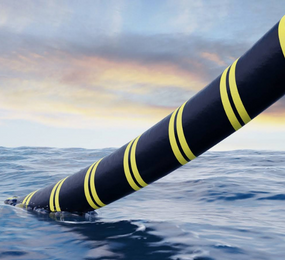The renewable energy sector is set to break barriers in the energy industry as concern for climate change and support for environmental, sustainability, and governance (ESG) considerations escalate and the high demand for cleaner energy is increasing. As the demand for clean energy rises, new solutions must be found to extend its possibilities.
Floating solar energy is an industry with foreseeable potential as plants can be easily installed on lakes, reservoirs, or offshore. It does not compete with land use and is also good for water conservation as it tends to limit water evaporation. Notwithstanding, there are a lot of challenges in the Floating Pv Industry ranging from installation methods, innovations, maintenance, and production costs.
Let's dive into some of the challenges encountered in the Floating solar PV Industry!
Mooring Systems and Cables
Amongst the many challenges faced by floating solar farms: the ability to withstand environmental loads tops the chart making the mooring design an unavoidable part of the Installation of Floating solar PV plants. Notably, the consequences of bad mooring design can be significant as seen in the Floating PV Plant Fire outbreak in Japan.
Mooring is one of the biggest challenges of floating solar photovoltaics (PV), compared to ground-mounted solar PV. To date, most mooring designs of industrial projects have been performed by computing environmental loads using an analytical analysis. An appropriate anchoring and mooring system is a very important part of a Floating PV plant as they are meant to withstand wind, wave, and current loads.
There are three basic ways to hold a floating platform in place; bank anchoring, bottom anchoring, or piles although bottom anchoring has been used for most vast projects in the FPV plants. In development, the design chosen is determined by the location, bathymetry, soil conditions, and variation in water level.
A Look at the LargeScale Plant Design
Most large-scale FPV plants have a pontoon-type float, upon which PV panels mount at a fixed tilt angle. The floating structure can consist of floats alone. Floats are made with metal trusses, special membranes, or mats. The system is held in place by the anchoring and mooring system. Worthy to note that wind load, float type, water depth, and variation in water are determinants of the design style. The entire layout of the floating PV plant is almost similar to the land-based PV systems.
When considering moorings for a floating body subjected to environmental loads, standards and protocols already exist for other floating applications such as Oil and Gas or floating wind turbines but not the same for floating solar, as it is a fairly new industry.
Issues in the Installation, Maintenance, and Transportation of Floating Solar Photovoltaic Projects
A significant portion of the installation and maintenance of floating Solar PV projects involves manual delivery on both land and water. The occupational risks on land and water associated with a typical floating solar photovoltaic project are alarming.
According to the European Agency for Safety & Health at Work (EU-OSHA) skill shortages are increasing in the renewable energy industries due to fast-paced innovations. The workflow includes but is not limited to unloading, transportation, and fabrication of unwieldy solar photovoltaic panels, gaskets, frames, bulky floats/pontoons, and electrical components. During the anchoring and mooring process, divers may suffer from hypothermia and risk of drowning due to prolonged exposure to solar radiation during installation. Also, electrical safety is an important aspect of FSPV installations as far as the proximity of electrical equipment to water and the interface with the workers is concerned as the workers risk being electrocuted from solar modules, inverters, and transformers. Furthermore, FSPV workers are also exposed to risks from the microclimate, which might present extreme temperatures, exposure to toxic chemicals, excessive noise, and vibration from the use of tools/equipment. Cleaning of solar panels during maintenance and repair/replacement of floaters involves prolonged work with water.
Any Remedy for This?
Design intervention is the most common way of addressing these issues.
Technology Cost and Innovations
Many floating solar technologies are under development and floating solar farms are currently being installed across the globe. There is a large potential worldwide for the floating solar market. As projects increase, complexities are unbecoming. As regards this, cost optimization is one of the main drivers in the design technology of the project. As the renewable energy source with the greatest potential for scalability, solar is increasingly being viewed as the most cost-effective method of enabling nations to hit their energy mix transition targets. Although the capital cost of Floating PV is still slightly higher than that of land-based PV, caused majorly by the need for floats, moorings, and more resilient electrical components as can be seen in the case of silicon and also the use of manual labor. The cost of floats is expected to drop over time as new technology tools are introduced. For instance, total capital expenditures for Turkey's floating PV installations in 2018 generally range between $0.8 -12 per Wp. Additionally, locations of projects, the depth of water, and the size of the system are to be considered as well when considering cost optimization and project techniques.
Future Of Floating Solar PV market?
Above all, according to the Solar Market report, amid these challenges in the floating solar PV Industry, there are foreseeable potentials and possibilities in the market considering the massive revenues generated from there and also government favorable policies and initiatives regarding clean energy sources.
Do you want to learn more exciting things about the Floating PV energy system? Well, Come for The Annual Floating Solar PV Forum organized by the Leadvent Group. Take this important step for your growth and establishment in the floating solar PV market both domestically and internationally.
Come and meet Key industry Players and increase your knowledge about the Floating solar PV Energy system which is making a great impact in the energy sector.
To request the agenda please send the request to Leadvent Group via email.
For more information and group participation, contact us: [email protected]
















